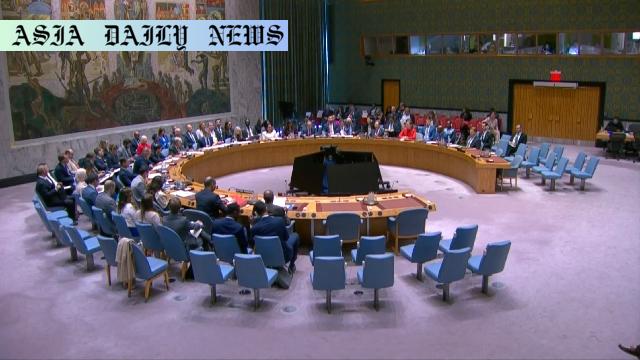South China Sea tensions escalate as China and the US clash over territorial rights at the UN Security Council meeting.
China and the US exchange strong accusations over maritime disputes in the South China Sea.
The Philippines’ territorial rights take center stage, with the US supporting Manila against China’s actions.
China accuses US military maneuvers of stirring tensions, while offering diplomatic reassurances.
Military drills in the affected region fuel diplomatic disparities.

Overview of South China Sea Disputes
The South China Sea has consistently been a flashpoint of geopolitical tension, primarily involving overlapping territorial claims by several nations. Global powers like the United States and China often find themselves at loggerheads over the region’s contested waters. Recently, these conflicts came to a head during a United Nations Security Council (UNSC) meeting in New York focused on maritime security. Both the US and China presented polarizing views, defending their respective roles while openly accusing the other of provocation.
According to acting US representative Ambassador Dorothy Shea, China’s actions in the South China Sea—particularly concerning the ongoing dispute with the Philippines—are both dangerous and illegal. The US has reiterated its unwavering support for the Philippines, emphasizing the importance of protecting territorial integrity and adherence to international maritime law.
China’s Perspective on Stability
Conversely, China’s deputy ambassador to the UN, Geng Shuang, argued against these allegations by highlighting the stability of the current situation in the region. China takes pride in its vision of transforming the South China Sea not into a territory of conflict but into “a sea of peace, friendship, and cooperation.” These assertions, however, are widely scrutinized in light of Beijing’s military presence and artificial island building within contested waters.
China also criticized the US for conducting military navigation exercises in the area. Shuang accused Washington of leveraging “freedom of navigation” as a facade for escalating confrontation and increasing military hardware presence. From Beijing’s perspective, the US approach exacerbates distrust and undermines progress within the region’s diplomatic frameworks.
The Role of Military Exercises
The military component of the South China Sea dispute remains undeniable. The joint maritime drills conducted by US and Philippine forces from late April to early May further illustrate the emerging power divide. Such exercises symbolize solidarity against perceived Chinese assertiveness yet simultaneously amplify fears of escalating conflict. Observers fear that reliance on military maneuvers could outpace critical diplomatic efforts, risking not only regional but global security.
At present, the interplay between diplomacy and militarization in the South China Sea reflects a widening polarity. Each side firmly believes in its own narrative, whether it’s China’s claims of rightful sovereignty or the US’s support for smaller ASEAN countries adhering to international maritime laws. These complexities require nuanced solutions built on communication and cooperation, rather than mere projection of power.
Looking Forward
Resolving tensions in the South China Sea demands a concerted effort by all involved parties. The recent UNSC exchange underlines the necessity of addressing not just legal disputes, but also the balance of power shaping the region. While China attempts to reassure the global community of peaceful intentions, its actions in the region invite skepticism. Similarly, the United States must weigh its involvement’s long-term impact, beyond just engaging in power politics. The stakes are far-reaching—not only for the claimants involved but also for global maritime security.
As these powerful nations continue deliberation, other claimant states and regional forums like ASEAN must actively participate in reinforcing the structures of rule-based order. Through dialogue and compromises, contentious waters can be navigated toward collective progress and security.
Commentary
The Delicate Dynamics of the South China Sea
The South China Sea dispute encapsulates some of the most critical aspects of contemporary geopolitics. This isn’t just about territorial claims—it’s about the larger conversation on international law, balance of power, and national sovereignty. Watching the United States and China, the two major global players, engage in a war of words at the United Nations highlights how deeply entrenched the conflict has become. From a global citizen’s perspective, such confrontations inspire both concern and curiosity about the future of diplomacy.
The Complexity of Military Dominance
China’s assertion of peaceful intentions in transforming the South China Sea “into a sea of peace” often stands at odds with its military expansion activities. Artificial islands and increased naval patrols don’t exactly scream harmony. However, the US’ continued demonstrations of military power through joint drills with allies like the Philippines bring up a different set of predicaments. When does military deterrence cross the line into provocation? The delicate balance between defense and intimidation remains at the heart of this regional, and increasingly global, conflict.
A Need for Genuine Dialogue and Cooperation
One of the most transformative solutions for tensions in global hotspots, including the South China Sea, is authentic dialogue. While accusations and finger-pointing dominate today’s narrative, this reactive approach only deepens mistrust and limits room for understanding. Diplomatic innovation, involving multilateral approaches, regional negotiations, and neutral mediation, could begin to pave constructive pathways towards resolution.
Lastly, meaningful cooperation means derailing nationalistic tendencies for the greater good. Smaller nations cannot play pawns in a larger struggle between superpowers. In this regard, the South China Sea serves as a beacon; how this unfolds could set a precedent on how humanity resolves contentious issues worldwide.


